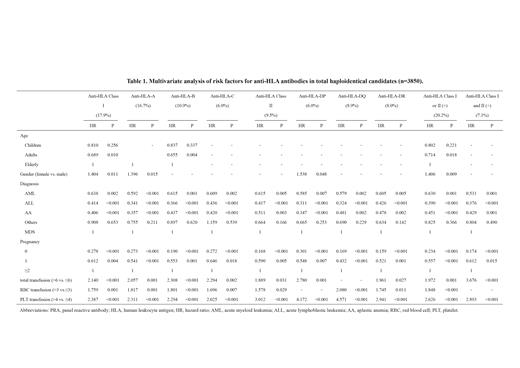Abstract
The aim of this study is to investigate the prevalence and risk factors of anti-human leukocyte antigen (HLA) antibodies in haploidentical candidates.
This study was completed at Peking University People's Hospital, Beijing China. We performed a prospective analysis of patients with hematological diseases concerning the prevalence and risk factors of anti-HLA antibodies. Patients were enrolled between July 2015 - December 2019. Serum was collected for PRAs test within 1 month before haploidentical transplantation. The risk factors, such as age, sex, total transfusion, red blood cell (RBC) transfusion, platelet (PLT) transfusion, pregnancy, disease duration and diagnosis were collected. Univariate and multivariate logistic regression analyses were performed to evaluate the risk factors of anti-HLA antibodies.
Six hundred and eighty (17.9%) patients were positive for panel reactive antibodies (PRA)-class I, 360 (9.5%) for class II, 768 (20.2%) class I or II, and 272 (7.1%) positive for class I and II both. Multivariate analysis indicated that female was related to higher risk of having PRAs for class I (P = 0.011), class I or II (P = 0.009), anti-HLA-A (P = 0.015), anti-HLA-DP (P = 0.048) and also for having higher mean fluorescence intensity (MFI) (2000 or more) of PRAs in class I (P = 0.020) and class I or II (P = 0.005). Compared to patients with myelodysplastic syndrome (MDS), patients with acute myeloid leukemia (AML), acute lymphoblastic leukemia (ALL), aplastic anemia (AA) had a lower incidence for PRAs in class I, class II, class I or II, class I and II, anti-HLA-A. anti-HLA-B, anti-HLA-C, anti-HLA-DQ, anti-HLA-DR, anti-HLA-DP (Table 1). Prior pregnancy was a risk factor for PRAs (P < 0.001), and no previous pregnancy group having lower MFI of PRAs in class I (P = 0.001) and class I or II (P = 0.004). PLT transfusion (more than 4 times) rleted with a higher prevalence of PRAs (P < 0.001), and also had a higher MFI of PRAs in class II (P < 0.001), class I and II (P < 0.001). Patients with RBC transfusion (more than 3 times) had a higher prevalence of PRAs in class I (P = 0.001), class II (P = 0.029), class I or II (P < 0.001), anti-HLA-A (P = 0.001), anti-HLA-B (P < 0.001), anti-HLA-C (P = 0.007), anti-HLA-DQ (P < 0.001) and anti-HLA-DR (P = 0.011). In addition, diseases duration (8 months or more) was also associated with higher MFI of PRAs in class I (P = 0.023) and class I or II (P = 0.004).
Subgroup analysis showed that 11.7% of pediatric patients were positive for PRAs in class I; 19.2% of adults, 17.9% of elder patients; 12.4% of males; 26.1% of females; 21.0% of patients with AML; 10.5% of patients with acute lymphoblastic leukemia (ALL); 18.9% of patients with AA; 30.3% of patients with MDS; 16.6% of patients with other hematological diseases. The positive rate of class II PRAs in children was 4.3%; 11.1% for adults; 9.5% for elder patients; 5.5% for males; 15.4% for females; 11.4% for patients with AML; 5.2% for patients with ALL; 10.3% for patients with AA; 17.2% for patients with MDS; 6.6% of patients with other hematological diseases. Multivariate analysis showed that, in children, PLT transfusion and diagnosis were the two main risk factors of PRAs in class I and class II (P < 0.001, P = 0.017). In adults, diagnosis (P = 0.003), transfusion (P < 0.001) and pregnancy (P < 0.001) were the three main factors associated with PRAs in class I and transfusion (P < 0.001) and pregnancy (P < 0.001) were the two main factors associated with PRAs in class II. In males, PLT transfusion (P < 0.001) and diagnosis (P < 0.001) were the two main factors associated with PRAs in class I and class II. In ALL subgroup, gender (P = 0.026, P = 0.048), pregnancy (P < 0.001) and transfusion (P < 0.001) were the three main factors associated with PRAs in class I and II. In AA subgroup, gender (P = 0.004) and PLT transfusion (P < 0.001) were risk factors for class I PRAs, pregnancy (P = 0.008) and PLT transfusion (P = 0.003) were risk factors for class II PRAs. In elder patients, females, AML, MDS and other diseases subgroup, transfusion and pregnancy were the two main factors associated with PRAs in class I and class II.
Our results indicated that female sex, diagnosis, pregnancy, transfusion, disease duration were independent risk factors of anti-HLA antibodies in haploidentical allograft candidates, which provided evidence for best haploidentical donor selection. The risk factors of anti-HLA antibodies were different among total patients and those of cases in different subgroups.
No relevant conflicts of interest to declare.


This feature is available to Subscribers Only
Sign In or Create an Account Close Modal